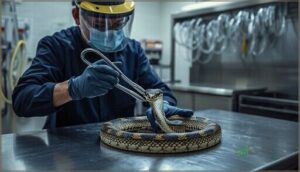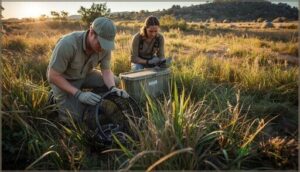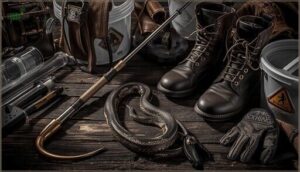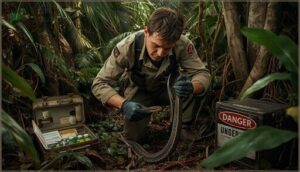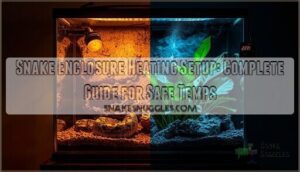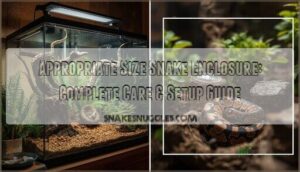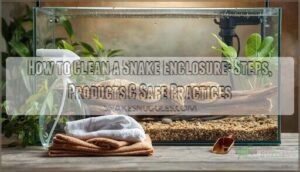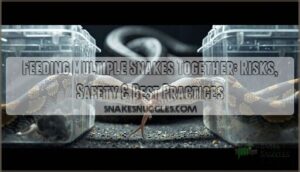This site is supported by our readers. We may earn a commission, at no cost to you, if you purchase through links.
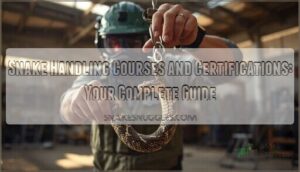
Most people freeze when they spot a venomous snake, but professionals move with practiced confidence, transforming a dangerous encounter into a controlled procedure. That gap between fear and competence isn’t about courage—it’s about training.
Snake handling courses and certifications teach you to read behavior patterns, deploy specialized equipment with precision, and execute emergency protocols that prevent fatal mistakes. Whether you’re pursuing wildlife management, research fieldwork, or animal control, formal certification establishes your credibility while drilling in the safety fundamentals that separate amateurs from professionals.
The right program builds both technical skills and the calm, methodical mindset you’ll need when a cottonmouth tests your nerve at arm’s length.
Table Of Contents
Key Takeaways
- Snake handling certification transforms instinctive fear into controlled competence through systematic training in species identification, behavior patterns, specialized equipment deployment, and emergency protocols that separate amateur risk-takers from credentialed professionals.
- Effective courses combine online theory with hands-on practice under expert supervision, maintaining strict student-to-instructor ratios of 5:1 during live venomous snake sessions and capping enrollment at 15 students to ensure safety and skill mastery.
- Certification requires passing both written assessments covering toxinology and snakebite management plus practical demonstrations of safe handling techniques, but doesn’t replace state-mandated permits that vary dramatically by jurisdiction and carry compliance monitoring with enforcement actions.
- Advanced specializations in field research, captive management, and wildlife control demand ongoing recertification every 1-3 years plus liability insurance coverage of at least $2 million to maintain professional credentials and operational legality.
Choosing a Snake Handling Course
You can’t master what you don’t understand, and choosing the right snake handling course sets the foundation for your journey into venomous reptile work. The right program will match your specific goals, whether you’re a wildlife operator responding to calls or a researcher tracking populations in the field.
Let’s break down the key factors that separate a solid training experience from one that leaves you unprepared.
Course Formats and Delivery (online Vs. In-person)
You’ll face a choice between online learning and in-person classroom training when selecting your venomous snake handling course. Online courses deliver theory, identification, and safety protocols through digital resources and virtual classes—accessible globally, often self-paced. Hybrid training combines webinar replay with onsite risk assessments and hands-on practice.
Since 2018, Australian providers have migrated flagship certifications fully online, achieving equivalent pass rates while expanding course accessibility internationally. Many institutions require personnel to complete an animal facility training before handling animals.
Class Sizes and Instructor Qualifications
Class size limits shape your venomous snake safety training experience. Most reputable programs cap enrollment at 15 students, tightening student ratios to 5:1 during hands-on individual training with live specimens.
Instructor qualifications matter—certified professionals generally bring decades of expertise in snake handling techniques. Look for instructors vetted through professional organizations, with backgrounds in herpetology or wildlife control, who enforce rigorous safety protocols throughout practical sessions.
Effective snake handling requires proper safety training protocols to minimize risks.
Providers and Recognized Organizations
Choosing the right organization unlocks your path to mastery. Regional providers like The Rattlesnake Conservancy and Save The Snakes deliver US Venomous Snake Safety and Handling Certified programs, while Snake RnR dominates Western Australia’s mining industry with regulatory compliance built-in.
- NWCOA backs venomous snake safety certification for wildlife control professionals nationwide
- PARC reviews training materials, ensuring conservation ethics meet industry recognition standards
- African Snakebite Institute leads continental expertise in ethical relocation and first aid protocols
- State wildlife agencies regulate permit requirements—your certificate of completion won’t replace mandatory licensing
Tailoring Courses to Specific Needs
Geographic tailoring transforms generic instruction into precision training. You’ll find 89% of training courses reshape course curriculum and content around your region’s rattlesnakes, copperheads, or coral snakes.
Private training course providers adapt professional snake handling techniques to your profession—whether you’re wiring utility poles or relocating research specimens.
Onsite and online training formats flex around your schedule, while skill adaptation ensures beginners master identification before skilled handlers perfect venom extraction. Risk emphasis adjusts to your operational reality.
Essential Venomous Snake Safety Training
Before you can confidently handle venomous snakes, you need to master the fundamentals that keep you alive. A solid safety training program doesn’t just teach you to recognize a copperhead—it rewires how you think about risk, preparation, and respect for the animal in front of you.
Real venomous snake training rewires your instincts around risk, preparation, and respect—not just species recognition
Here’s what every reputable course will cover to transform you from cautious beginner to capable handler.
Snake Identification and Biology
You can’t master what you can’t identify. Snake identification and snake biology form your foundation—understanding snake anatomy and physiology, venom delivery systems, and snake species distinctions between elapids and pit vipers.
You’ll explore snake habitat adaptations and ecological roles while learning how species misidentification compromises safety.
Modern courses increasingly incorporate AI identification tech, achieving 96% accuracy, helping you to recognize threats confidently and respond decisively when snake behavior signals danger.
Safety Protocols and Equipment
Safety protocols and handling equipment transform chaos into control. Snake hooks (63.8% of handlers require them) and tongs (47.4%) are essential tools, along with protective gear like boots and gloves—though gloves won’t prevent venomous bites. Equipment inspection prevents mechanical failure during critical moments.
Emergency response training teaches bite prevention fundamentals: keep snakes below strike range, never tail or neck them, and maintain laser focus on positioning.
Governmental support remains inadequate, but handler training bridges gaps effectively.
Snake Behavior and Ecology
Understanding snake behavior and ecology turns fear into informed respect. Venomous species demonstrate seasonal activity peaks driven by temperature and humidity, while their defensive responses vary with body size—smaller snakes bite more readily.
You’ll master essential patterns:
- Habitat diversity: Arboreal species dominate forests; fossorial snakes thrive in arid, sandy environments
- Snake communication: Chemical detection via forked tongues, vibrational signals, and auditory warnings like rattling
- Ecological balance: Snakes control rodent populations while serving as prey themselves
Snake migration patterns and venom evolution reflect millions of years adapting to environmental pressures. This knowledge equips wildlife conservation efforts and strengthens reptile safety protocols during field encounters.
First Aid and Snakebite Management
You can’t afford panic when seconds matter—swift, evidence-based first aid determines snakebite survival. Training covers snakebite symptoms recognition, venom effects assessment, and emergency response protocols that save lives.
You’ll learn pressure immobilization techniques, proper wound care, and why tourniquets fail. Snake bite management emphasizes rapid hospital transport for antivenom administration, while first aid kits remain inadequate without professional intervention.
Snake bite prevention starts with knowledge; snake bite treatment demands precision under pressure.
Hands-on Snake Handling Techniques
You can’t master venomous snake handling by reading alone—you need your hands in the work. These courses put you face-to-face with live snakes under expert supervision, where every movement matters and mistakes aren’t an option.
Here’s what you’ll actually learn when the rubber meets the road.
Safe Handling of Live Venomous Snakes
You’ll work directly with live venomous snakes under controlled conditions, transforming theory into real-world competence. Proper handling equipment, including polymer snake tongs and transparent restraint tubes, keeps both you and the animal safe during manipulation.
Snake behavior guides every movement—recognizing defensive postures prevents venomous bites. Pair work and emergency response protocols guarantee immediate assistance, while safety measures like face shields protect against spitting species during hands-on sessions.
Trapping and Relocation Methods
Effective snake removal and relocation demands mastery of proven trapping systems that prioritize both capture success and animal welfare. You’ll learn humane trapping techniques, habitat suitability assessment, and post-release monitoring protocols that transform field challenges into conservation victories.
- Funnel traps capture multiple snakes simultaneously with minimal escape risk
- Relocation stress decreases when you minimize transport distances and time
- Post-release monitoring reveals survival rates averaging 50% or higher in successful translocations
- Habitat suitability directly influences site fidelity and long-term survival outcomes
- Ethical considerations guide delayed release strategies that improve snake adaptation
Use of Handling Equipment
Professional snake handling demands specialized equipment that transforms danger into calculated control. Snake hooks with anodized aluminum shafts and snake tongs of 1.5 meters give you the reach and precision needed for safe venomous transport. Quality matters—cheap imports fail when you need them most.
Protective gear including boots, tubes, and buckets marked clearly for venomous species complete your arsenal, while proper handling techniques turn intimidating encounters into mastery moments.
Practice Sessions and Supervised Exercises
Having the right gear means nothing until you put it to work. Practical training sessions run 8 to 10 hours, where you’ll handle LIVE venomous snake handling under expert supervision. Your hands-on individual training includes:
- Controlled exposure to 8+ venomous species
- Supervised handling with certified herpetologists
- Target training techniques reducing snake aggression
- Risk management protocols preventing envenomation
Safety measures transform fear into confidence—95% of trained handlers accurately distinguish venomous from non-venomous snakes post-certification.
Certification Requirements and Process
Getting certified isn’t just about showing up—you’ll need to prove you can handle venomous snakes safely through both written knowledge and hands-on skill demonstrations. The certification process transforms you from student to recognized professional, opening doors to higher-level training and real-world applications.
Here’s what stands between you and that certificate of completion.
Written and Skills Tests
Certification hinges on two evaluations: a written and practical test covering venomous snake identification, toxinology, and snakebite management. You’ll face multiple-choice questions, true/false items, and short answers after roughly seven hours of instruction.
The skills assessment requires demonstrating safe handling methods with live venomous snakes under supervision, using proper snake handling equipment like hooks and tongs while following strict safety protocols throughout.
Certificate of Completion and Logo Mark Usage
Once you pass, you’ll receive a certificate valid for two years—your proof of mastery in snake safety training courses.
Certified professionals can display the logo mark on official materials, but logo restrictions apply: no modifications, no vehicles, no product packaging.
Renewal processes require updated applications before expiration. Compliance audits verify proper usage, and unauthorized usage risks suspension.
This snake safe certification program demands precision, not just in handling, but in representing your credentials.
Prerequisites for Advanced Courses
More in-depth courses reveal the next level of mastery, but you’ll need to prove your foundation first. Most programs require:
- Minimum age of 18 years for Level 2 enrollment
- Prior certification from a recognized Level 1 or Basic Safety and Handling course
- Health criteria including current first aid certification and medical clearance
- Skills prerequisites demonstrated through passing scores in Venomous Snake Safety Training assessments covering Snake Behavior and Biology
- Booking requirements with advance notice, often months ahead due to limited spots
State and Local Permit Considerations
Beyond course certification, you’ll navigate a landscape of permit requirements and local regulations that vary dramatically by state. Completing a snake-handling course doesn’t replace the legal permits you need—state laws and wildlife agencies each set their own rules for handling venomous reptiles.
Compliance monitoring by wildlife agencies includes regular audits and enforcement actions—Florida alone issued 152 citations over five years for violations like improper caging. OSHA Standard considerations and risk management protocols also apply if you’re handling snakes professionally, adding another layer to permitting requirements you can’t ignore.
| State | Permit Type | Annual Cost | Reporting Required | Local Override |
|---|---|---|---|---|
| Florida | FWC Venomous License | $20-$100 | Escape/bite protocol | Yes |
| Pennsylvania | Fish + Venomous Permit | Variable | Online catch report | Municipality adds |
| Kansas | Prairie Rattler Permit | $22.50 | Activity log | Limited |
| Georgia | Exotic/Venomous Permit | $20-$100 | Incident reporting | Yes |
| Arizona | None (native species) | $0 | Voluntary | City-specific |
Cancellation and Refund Policies
Before committing to a training course, you’ll want to understand the cancellation policy and refund procedures that govern your enrollment. Most certified professionals offering private training courses require 30 days’ advance notice for full refunds, minus a $25–$50 administrative fee. Cancellation fees escalate to 50–100% of tuition with shorter notice.
Payment terms usually allow transfer policies for date changes if requested 14+ days ahead—critical for risk management in your planning.
Advanced Specializations and Career Applications
Once you’ve earned your certification, you’re ready to step into specialized roles that push beyond basic handling. Whether you’re tracking pit vipers in the field, managing captive collections, or responding to venomous snake calls for wildlife agencies, higher-level training sharpens your expertise and creates opportunities.
Here’s how you can transform your certification into a career that commands respect and mastery.
Level 2 Field Research and Biological Sampling
You’ll master the art of scientific fieldwork through Level 2R INTRODUCTION TO FIELD RESEARCH TECHNIQUES, where Conservation Biology meets practical application.
This Wildlife Control Training track teaches you Field Sampling protocols, Biological Analysis methods, and Research Methods essential for studying Snake Habitats.
You’ll gain expertise in snake biology and Field Herping Research Track techniques, combining Herpetology theory with hands-on sampling that advances real-world conservation efforts.
Captive Venomous Reptile Management
Ever wondered what separates a hobbyist from a true master of captive venomous reptile management? You’ll learn to maximize Venom Yield and enforce strict Snake Enclosures and Reptile Housing standards. Venom Extraction cycles, Captive Breeding, and hands-on Venomous reptile handling training become daily rituals.
- Secure enclosures
- Thorough health protocols
- Precision in venom extraction
- Unyielding safety discipline
Wildlife Control and Animal Management
Can you feel the pulse of the wild when a snake slides beneath your boots? Wildlife Control Operators and Animal Control officers stand at the frontlines, balancing Animal Welfare and Ecosystem Balance. Your training in Species Management and Habitat Preservation ensures every intervention in Wildlife management and snake control upholds Wildlife safety.
| Role | Key Skill | Core Outcome |
|---|---|---|
| Wildlife Control Ops | Species Management | Ecosystem Balance |
| Animal Control | Wildlife safety | Animal Welfare |
| Snake Control | Habitat Preservation | Wildlife Conservation |
Safety Standards in Professional Settings
When you step into professional venomous snake work, Regulatory Compliance and Safety Protocols become your armor. You’ll rely on Personal Protective Equipment—gloves, gaiters, and hooks—that reduce bite risk by 58%.
Emergency Response plans, Risk Assessment before every encounter, and pair-work protocols in 84% of operations guarantee Venomous Snake Safety isn’t negotiable. These Safety Standards protect you, your team, and the mission itself.
Continuing Education and Recertification
Your certification doesn’t end at the finish line—staying sharp requires renewal every three years through the Recertification Process. Online Refresher modules cover Safety Updates and evolving Compliance Standards, while Wildlife Safety Education covers new Risk Management Training protocols.
Renewal Requirements usually include:
- Documented continuing education credits in venomous snake biology
- Written and practical skills assessments
- Proof of current state permits
This cycle keeps your Venomous Snake Safety Training aligned with OSHA Training Requirements and top Safety Certification Courses.
Frequently Asked Questions (FAQs)
What insurance coverage is recommended for handlers?
Like a safety net under a high wire, liability insurance forms your foundation—aim for $2 million in public risk coverage, plus professional indemnity and medical protection customized specifically for wildlife management professionals.
Are there age restrictions for course enrollment?
Most venomous snake handling courses require you to be at least 18 years old, though basic awareness training may accept participants starting at Liability waivers and parental consent apply to minors in certain programs.
How long does certification remain valid?
Your snake handling certification usually stays valid for 12 months, though some programs extend this to two years.
You’ll need to complete refresher courses or retake certification exams to maintain your credentials and stay current with evolving safety protocols.
Can international students take these courses?
Yes, you can enroll if you meet eligibility criteria like age, language proficiency, and visa requirements.
International fees and enrollment processes vary by provider, so verify your status before committing to venomous snake safety training.
What happens if you fail the certification exam?
Failing the written exam means you won’t receive your venomous handling certification course credential.
Most programs require remediation training before retake policies allow another attempt, usually after 90 days, with legal restrictions on fieldwork remaining until you pass.
Conclusion
You won’t transform into a fearless handler overnight, but snake handling courses and certifications will forge the reflexes and judgment that keep you alive when milliseconds matter.
Every protocol you memorize, every hook technique you drill, and every behavioral cue you master builds the foundation between you and disaster.
The stakes are unforgiving, but the path forward is clear: formal training turns instinctive panic into deliberate action, and that shift makes all the difference.


